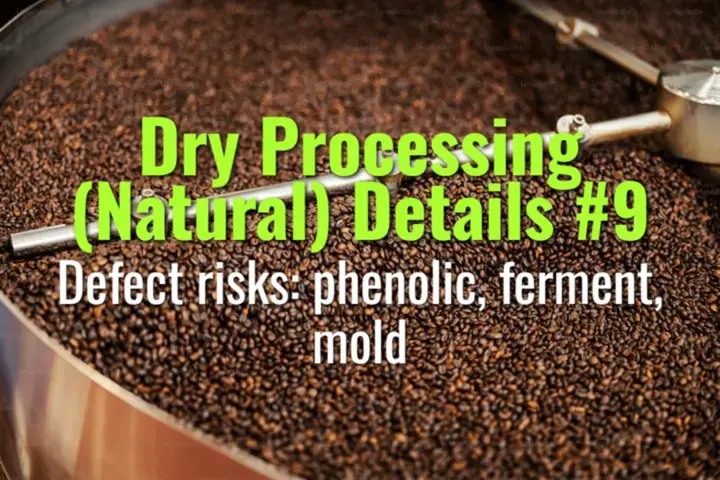Defect risks: phenolic, ferment, mold
This topic explains the main defect risks in natural (dry) coffee processing—phenolic, ferment, and mold defects—how they arise, and strategies for prevention.
- Coffee Basics Nerds
- 2 min read
Article 9 of 12 in Dry Processing (Natural) Details/

Why Defects Occur in Naturals
- In naturals, cherries dry whole with pulp and mucilage intact.
- High sugar and moisture levels create a fertile environment for microbial growth.
- Without careful management, defects develop that permanently degrade cup quality.
Key Defect Risks
1. Phenolic Defects
- Cause: Contamination by wild yeasts, bacteria, or poor sanitation.
- Cup Impact: Medicinal, plastic, or smoky notes.
- Prevention:
- Strict cherry selection (remove unripe/overripe).
- Clean drying beds and equipment.
- Avoid contamination from dirty water or soil.
2. Ferment Defects
- Cause: Over-fermentation during slow or uneven drying.
- Cup Impact: Sour, vinegar-like, alcoholic flavors.
- Prevention:
- Thin cherry layers (3–5 cm).
- Frequent turning, especially in first 3–5 days.
- Use raised beds or solar dryers for airflow.
3. Mold Defects
- Cause: Prolonged high moisture or re-wetting during drying/storage.
- Cup Impact: Musty, earthy, baggy notes; potential mycotoxins (ochratoxin A).
- Prevention:
- Dry cherries to 10–12% moisture.
- Protect from rain/humidity with covers or solar dryers.
- Store in cool, dry, ventilated warehouses.
Consequences of Defects
- Even small percentages of defective beans can dominate a cup profile.
- Specialty-grade lots downgraded to commercial grade.
- Financial losses for producers due to rejection by buyers.
Best Practices for Risk Management
- Rigorous cherry selection at harvest and reception.
- Sanitation of equipment and drying areas.
- Frequent turning and monitoring moisture content.
- Segregate lots to isolate problems early.
Lasting Importance
Defect risks in natural processing are high but manageable. By carefully controlling fermentation, airflow, and drying, producers can avoid phenolic, ferment, and mold defects—protecting both cup quality and farm income in specialty markets.
You might also like:
- Tags:
- Lasting Importance
- Best Practices
- Cup Quality
- Specialty Markets
- Moisture Content
- Specialty Grade
- Uneven Drying
- Raised Beds
- Natural Processing
- Risk Management
- Cup Profile
- Solar Dryers
- Microbial Growth
- Cool Dry
- Commercial Grade
- Frequent Turning
- High Sugar
- Drying Beds
- Drying Storage
- Avoid Contamination
- Defective Beans
- Phenolic Defects
- Defects Occur
- Grade Lots
- Moisture Levels
- Earthy Baggy
- Yeasts Bacteria
- Cherries Dry
- Unripe Overripe
- Beds Solar